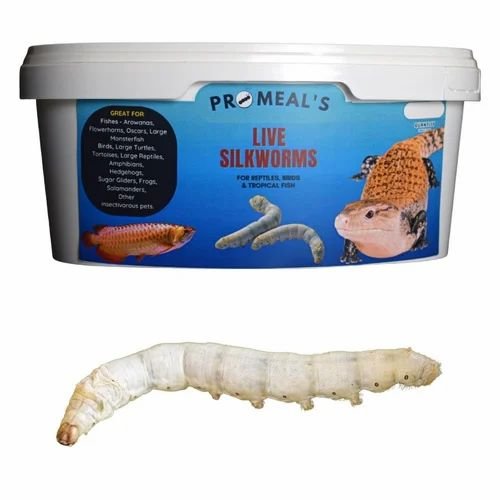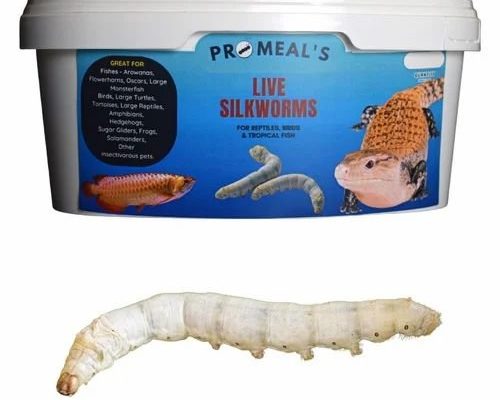
Feeding reptiles and fish silkworms is like giving them a gourmet meal instead of a fast-food burger. They’re beneficial for a wide range of pets, adding variety to their diets while being packed with essential nutrients. So, let’s dive deeper into this intriguing food source.
What Are Silkworms?
Silkworms, scientifically known as *Bombyx mori*, are the larvae of the silk moth. These worms are primarily raised for their silk, but they also serve as a nutritious food source for many reptiles and fish. In the wild, they munch on mulberry leaves, but when bred for pets, they are often fed a special diet to enhance their nutritional value.
You might be wondering how these worms stack up nutritionally against other feeder insects. Honestly, they shine in several areas. They are higher in protein than crickets and have a fat content that’s beneficial for reptiles needing to build energy reserves. Plus, they are softer than other insects, making them easier to eat, especially for younger or smaller pets.
When you think about **feeding live insects**, silkworms present a unique option. Unlike mealworms or crickets, which can be a bit crunchy, silkworms have a soft body, allowing them to be more palatable, especially for finicky eaters.
Benefits of Feeding Silkworms to Reptiles
Feeding silkworms to reptiles can be a game changer for their health and happiness. These worms are rich in protein, essential fatty acids, and vitamins. For example, they contain significant amounts of **vitamin B12**, which is crucial for energy metabolism and overall health.
Here’s the thing—reptiles often thrive on variety in their diet. Just like we would get bored eating the same meal every day, reptiles appreciate having different food options. Silkworms add that extra layer of excitement. Offering silkworms can also help stimulate natural hunting behaviors, keeping your pet active and engaged.
Additionally, if you’re caring for a reptile that’s in the process of shedding, silkworms can be a perfect addition to their diet. The high moisture content can help facilitate this process, making shedding easier for them.
Benefits of Feeding Silkworms to Fish
Fish can also benefit tremendously from silkworms. They’re an excellent source of protein and can make up part of a balanced diet. Some fish species, particularly those that are omnivores or carnivores, can thrive on a diet that includes silkworms.
When you feed your fish silkworms, you’re essentially giving them a highly digestible food option. This is important since fish metabolize food differently than reptiles. The softer nature of silkworms means less effort in digestion, which can lead to healthier fish overall.
Moreover, the nutritional profile of silkworms helps promote vibrant colors in fish, making them more visually appealing. Who doesn’t want a beautiful aquarium filled with healthy, lively fish? By providing silkworms, you’re enriching their diet and promoting their natural hues.
How to Feed Silkworms to Your Pets
Getting started with silkworms is fairly straightforward. You can purchase them online or at specialty pet stores. When you receive them, it’s essential to keep them in a suitable habitat, usually a ventilated container with some food for them to munch on.
When it comes to feeding, you’ll want to offer a quantity that your pet can eat in a single sitting. For reptiles, you might start with a few worms and see how they respond. If they gobble them up quickly, you can gradually increase the amount.
For fish, gently dropping in a few silkworms can be enough. Just remember to monitor how many your fish consume in one feeding to avoid overfeeding. Uneaten food can pollute the water, which isn’t good for anyone involved.
Considerations When Feeding Silkworms
While **silkworms** have many benefits, there are still a few considerations to keep in mind. First, they should be treated as a supplement rather than the sole diet for your pets. It’s important to maintain a balanced diet that includes a variety of foods.
Another consideration is the source of your silkworms. Always buy them from reputable suppliers to ensure they are healthy and free from pesticides. You wouldn’t want to introduce harmful substances into your pet’s diet, right?
Lastly, keep an eye on your pets’ reactions. Some animals might take to silkworms right away, while others may be hesitant. If you notice your pet showing any signs of discomfort or illness after eating them, it’s best to consult with a vet.
Comparing Silkworms to Other Feeder Insects
When considering silkworms as feed, it’s helpful to compare them to other popular feeder insects like crickets and mealworms.
- Crickets: Crickets are a staple for many reptile keepers. They offer a great source of protein but can be a bit tougher for smaller reptiles to consume. They’re also known for being quite noisy!
- Mealworms: Mealworms are another popular choice but have a hard exoskeleton, making them less ideal for young or delicate pets. They are also lower in protein compared to silkworms.
- Silkworms: Silkworms have the advantage of being soft and high in protein and fat, making them easier to digest and a great option for many reptiles and fish.
When you weigh the pros and cons, silkworms often emerge as a favored option, particularly for those pets that need a softer food source.
Silkworms can be a fantastic addition to your reptiles’ and fish’s diets. They’re not just an exotic option; they’re a nutritious food that can keep your pets healthy and happy. With their soft texture and rich nutrient profile, silkworms can spark joy in feeding time and ensure your pets receive the balanced nutrition they need.
As you explore this unique food source, remember the importance of variety and balance in their diets. Silkworms could indeed be the gourmet snack your pets didn’t know they were missing. So why not give them a try? You might just find that both you and your pets appreciate this little shake-up in the menu!

